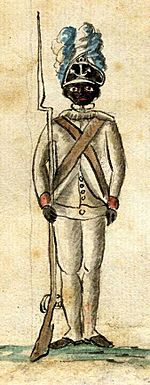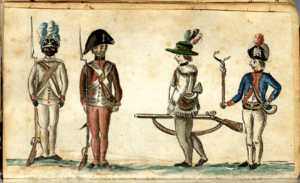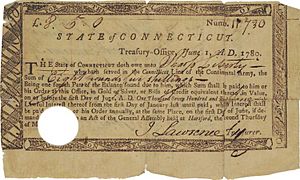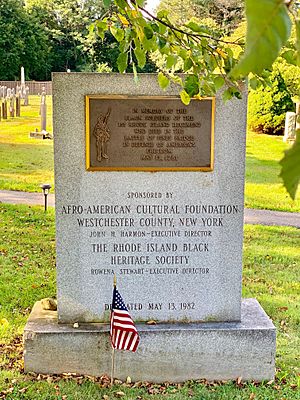1st Rhode Island Regiment facts for kids
Quick facts for kids Varnum's Regiment9th Continental Infantry Regiment 1st Rhode Island Regiment Rhode Island Regiment Rhode Island Battalion |
|
|---|---|

A 1781 watercolor of a black soldier from the 1st Rhode Island Regiment. This regiment had many black soldiers.
|
|
| Active | 1775–1783 |
| Country | |
| Allegiance | |
| Branch | |
| Type | Infantry |
| Part of | Rhode Island Line |
| Nickname(s) | Varnum's Continentals (1775–76) Black Regiment (1778–80) |
| Colors | white uniforms |
| Engagements | Siege of Boston New York campaign Battle of Red Bank Battle of Rhode Island Siege of Yorktown |
| Commanders | |
| Notable commanders |
James Mitchell Varnum, Christopher Greene, Jeremiah Olney |
| Insignia | |
| War Flag | |
The 1st Rhode Island Regiment was a special group of soldiers from Rhode Island. They fought in the Continental Army during the American Revolutionary War (1775–83). This regiment was one of the few that served for the entire war. They fought from the Siege of Boston in 1775 until the army was officially ended in 1783.
This group of soldiers had several names over time, like "Varnum's Regiment" and the "9th Continental Regiment." It became famous as the "Black Regiment" because it had many black soldiers. Some people even consider it the first black military unit, even though it also had white soldiers.
Contents
- Regimental History: A Journey Through the War
- Disbandment: Returning Home
- Key Battles and Locations
- Important Leaders
- Legacy: Remembering Their Service
Regimental History: A Journey Through the War
Varnum's Regiment: The Start (1775)
The 1st Rhode Island Regiment began before the United States was fully formed. The government of Rhode Island created it on May 6, 1775. It was led by Colonel James Mitchell Varnum, so people often called it "Varnum's Regiment." It started with eight companies of volunteers.
In June 1775, the regiment marched to Roxbury, Massachusetts. There, they joined the Siege of Boston, where American forces surrounded the British army. On July 28, the regiment became part of General George Washington's main army. The soldiers served until the end of 1775, when their enlistment ended.
9th Continental Regiment: New Name, New Fights (1776)
At the start of 1776, the Continental Army changed its structure. Varnum's Regiment was renamed the 9th Continental Regiment. They stayed near Boston until the British left the city in March.
After that, the regiment moved to New York. They fought in the difficult New York and New Jersey campaign. This included battles like the Battle of Long Island and the Battle of Harlem Heights. They had to retreat from New York with the rest of the army. At the end of 1776, soldiers could choose to join for three years or for the whole war.
1st Rhode Island Regiment: A Strong Defense (1777–80)
In 1777, the army changed names again. The 9th Continental Regiment became the 1st Rhode Island Regiment. Colonel Varnum was promoted, and Colonel Christopher Greene took command.
Under Colonel Greene, the regiment bravely defended Fort Mercer on October 22, 1777. This was during the Battle of Red Bank. They successfully fought off an attack by 2,000 Hessian soldiers. Hessians were German soldiers hired by the British.

The "Black Regiment": Freedom and Service (1778–81)
For a while, black men were not allowed to serve in the Continental Army. But by 1778, Rhode Island needed more soldiers. General Varnum suggested enlisting slaves. On February 14, 1778, the Rhode Island government voted to allow "every able-bodied negro, mulatto, or Indian man slave" to join.
If a slave joined and passed a check, they would immediately become free. Their owners would be paid for their freedom. About 88 slaves and some free black men joined the regiment. The regiment had about 225 men in total, with probably fewer than 140 being black.
The 1st Rhode Island became the only regiment with separate companies of black soldiers. Other regiments that allowed black men had them serve alongside white soldiers. Enlisting slaves was a debated topic, and no more non-white men joined after June 1778. Even so, the unit was still known as the "Black Regiment." Over time, as new white soldiers joined, it became an integrated unit.
Battle of Rhode Island: Holding the Line
In August 1778, the regiment fought in the Battle of Rhode Island. They played a very important part. They defended a fort and successfully stopped three attacks by the Hessians. The British and Hessian forces tried repeatedly to break their line, but they failed. This allowed the American army to retreat safely.
One historian noted that the Hessian colonel was so frustrated that he wanted to leave his command. He feared his own men might shoot him because of their heavy losses. The 1st Rhode Island Regiment had only three soldiers killed, nine wounded, and eleven missing.
General Sullivan praised the regiment for their actions. He said they "bore a proper share of the day's honors." General Lafayette called it "the best fought action of the war." After this battle, the regiment saw less action for three years. The war's main focus shifted to the southern states.
Rhode Island Regiment: Later Years (1781–1783)
On January 1, 1781, the 1st Rhode Island Regiment combined with another unit. It was then called the Rhode Island Regiment. They spent the early part of 1781 in the "Neutral Zone" of the Hudson River Valley.
Life in the Neutral Zone
The "Neutral Zone" was a dangerous area between American and British forces. People living there faced theft, murder, and destruction. Renegade groups, like the "cowboys" (who supported the British) and "skinners" (who supported the Americans), often raided the area. They would steal supplies for their side.
To protect the area, Colonel Greene and the Black Regiment were sent to defend Pine's Bridge. This bridge was often attacked by the "cowboys" from Morrisiania.
Battle of Pine's Bridge: A Sad Loss
On May 14, 1781, Colonel Delancey and his loyalist militia attacked Pine's Bridge. They surprised Colonel Greene and the Rhode Island Regiment. Colonel Greene, Major Ebenezer Flagg, and eight black soldiers were killed. Reports said the black troops "defended their beloved Col. Greene so well that it was only over their dead bodies that the enemy reached and murdered him." Colonel Greene and Major Flagg were buried in Yorktown.
Last Years: Yorktown and Beyond
After Colonel Greene's death, Lieutenant Colonel Jeremiah Olney took command. Under Olney, the regiment fought in the Siege of Yorktown in October 1781. This was the last major battle of the Revolution.
After Yorktown, the regiment moved to Newburgh, New York. Their job was to be ready if the British in New York City attacked. In January 1783, they were part of an expedition to capture Fort Ontario. The attack was called off at the last minute. The regiment then returned to Newburgh.
Rhode Island Battalion: The End of Service (1783)
On March 1, 1783, the regiment was reorganized into six companies. It was renamed the Rhode Island Battalion, or "Olney's Battalion." On June 15, many veterans were discharged. The remaining soldiers formed a smaller battalion of two companies.
The British left New York on November 25. The Rhode Island Battalion was officially ended on December 25, 1783. It was one of the few units that served for the entire time the Continental Army existed.
Disbandment: Returning Home
The Rhode Island Regiment spent its final days in Saratoga, New York. On December 25, 1783, the soldiers received their discharge papers. Many soldiers, both white and black, faced financial problems after the war. White soldiers were promised 100 acres of land and a pension.
The Rhode Island government had already promised freedom to the black soldiers after the war. On February 23, 1784, Rhode Island passed a law saying that no person born in Rhode Island after March 1, 1784, could be made a slave. The law also said that towns had to support children born to slaves.
Colonel Olney, the last commander, gave the regiment's flag to the Rhode Island government. He continued to fight for his former soldiers. He wanted them to stay free and get the pay or pensions they deserved. In 1784, 13 black veterans hired someone to help them get their back pay. In response, Rhode Island passed a special law in 1785. This law said that any "Indian, negro or mulatto" who was sick or poor must be cared for by their town. Most black veterans stayed in Rhode Island, but some moved to the land they were promised in New York or Ohio. Many veterans, both black and white, faced poverty after the war.
Key Battles and Locations
- Siege of Boston (May 1775 to March 1776)
- Battle of Bunker Hill (June 17, 1775)
- Battle of Long Island (August 22, 1776)
- Battle of Harlem Heights (September 16, 1776)
- Battle of White Plains (October 28, 1776)
- Battle of Trenton (January 2, 1777)
- Battle of Princeton (January 3, 1777)
- Battle of Red Bank (October 22, 1777)
- Siege of Fort Mifflin (October 23 to November 16, 1777)
- Valley Forge (December 19, 1777 to June 19, 1778)
- Battle of Rhode Island (August 29, 1778)
- Stationed at Bristol, Rhode Island (September 1778)
- Winter Quarters in Warren, Rhode Island (December 1778 to Spring 1779)
- Aquidneck Island, Rhode Island (October 1779 to January 1781)
- Quartered in upstate New York (January 1781 to December 25, 1783)
- Battle of Pine's Bridge (May 14, 1781)
- Siege and Battle of Yorktown (September 28 to October 19, 1781)
- Quartered at Newburgh, New York (1782)
- Oswego Expedition (January to February 1783)
Important Leaders
Colonels and Commanding Officers
- Colonel James Mitchell Varnum; May 3, 1775 - February 27, 1777 (promoted)
- Colonel Christopher Greene; February 27, 1777 - May 14, 1781 (killed in action)
- Lieutenant Colonel Commandant Jeremiah Olney; May 14, 1781 - December 25, 1783 (discharged)
Lieutenant Colonels
- James Babcock; May 3, 1775 - December 31, 1775
- Archibald Crary; January 1, 1776 - December 31, 1776
- Adam Comstock; January 1, 1777 - April 1778
- Samuel Ward Jr.; May 5, 1779 - December 31, 1780
- Jeremiah Olney; January 1, 1781 - May 14, 1781 (became commander)
Majors
- Christopher Greene; May 3, 1775 - December 31, 1775
- Christopher Smith; January 1, 1776 - October 27, 1776
- Henry Sherburne; October 28, 1776 - January 11, 1777
- Samuel Ward Jr.; January 12, 1777 - May 26, 1778
- Silas Talbot; October 10, 1777 - November 12, 1778
- Ebenezer Flagg; May 5, 1779 - May 14, 1781 (killed in action)
- Coggeshall Olney; August 25, 1781 - March 17, 1783
- John S. Dexter; August 25, 1781 - November 3, 1783
Legacy: Remembering Their Service
There is a monument to the 1st Rhode Island Regiment at Patriots Park in Portsmouth, Rhode Island. This is where the Battle of Rhode Island took place. The original flag of the regiment is kept at the Rhode Island State House in Providence.
Colonel Greene and Major Flagg are buried at the First Presbyterian Church in Yorktown, New York. A large monument honors them there. Next to Greene's marker, there is a stone memorial for the black soldiers who died defending them. This memorial was added to the African American Heritage Trail of Westchester County in 2004.




